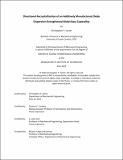Directional Recrystallization of an Additively Manufactured Oxide Dispersion-Strengthened Nickel-Base Superalloy
Author(s)
Carter, Christopher P.
DownloadThesis PDF (5.340Mb)
Advisor
Cordero, Zachary C.
Hart, A. John
Terms of use
Metadata
Show full item recordAbstract
This thesis investigates the recrystallization behaviors of an additively manufactured (AM) oxide dispersion-strengthened (ODS) NiCoCr medium entropy alloy, focusing specifically on the effects of a liquid phase, annealing twins, and aluminum microalloying additions on recrystallization kinetics. Conventional wrought ODS alloys achieve coarse columnar grains through directional recrystallization (DRX) heat treatments. The main goal of this study was to assess whether directional recrystallization can achieve a similar effect in AM ODS alloys. Gas-atomized NiCoCr powders were decorated with oxide dispersoids using resonant acoustic mixing then consolidated with laser powder bed fusion. The as-printed ODS materials were fully dense with retained nanoscale Y2O3 dispersoids and a small grain size of order 10 μm. The as-printed materials were subjected to isothermal recrystallization and directional recrystallization heat treatments at soak temperatures between 800 and 1419 °C. During isothermal annealing the material only recrystallized when the soak temperature exceeded the solidus or Al alloying additions accelerated the coarsening kinetics of the oxide dispersoids. Directional recrystallization experiments on the non-ODS alloy did not result in the formation of columnar grains likely due to the propensity of recrystallized NiCoCr to form annealing twins which are less mobile than grain boundaries. Directional recrystallization in the ODS NiCoCr could not be achieved without surpassing the solidus temperature of the alloy.
Date issued
2024-05Department
Massachusetts Institute of Technology. Department of Mechanical EngineeringPublisher
Massachusetts Institute of Technology